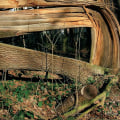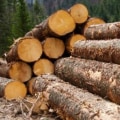Directional felling is a tree felling technique where the operator determines the direction of the fall before making any cuts. This method is often used to minimize damage to surrounding standing timber by aligning the fall with existing crown hollows. Trees are ideally felled toward or away from skid tracks, with an oblique angle to the yaw direction preferred. Felling away from skid tracks reduces complications for extraction equipment when treetops are large, while felling toward skid tracks can shorten the extraction distance.
In forestry operations, organization plays a critical role. Two common organizational structures are line organization, where all staff are positioned in a descending line, and pyramid organization, where a chief sits at the top with subordinates below. For efficient forest management, data such as tree population and size must be collected, often through Continuous Forest Inventory (CFI) practices. This data is essential for determining yields for specific forest management units or logging series.
The timing of tree felling significantly affects regrowth. Trees cut during the dormant season generally exhibit better stem survival, shoot growth, and initial regeneration. Post-felling, trees may be processed through burning, chipping, peeling, bark treatment, or solarization. In cases of pest infestations, sanitation measures like felling and treating bark beetle-infested trees are implemented to reduce pest populations.
Strategic forest management includes maintaining corridors, such as 30-meter-wide connections between clearcut sections and natural areas like riparian communities. This method is used in Indonesia's dominant dipterocarp concessions, which operate on a 35-year logging cycle. Logging impacts canopy mammals by removing fruitful species, increasing hunter access, and reducing forest structural complexity. Harvesting when the market is ready helps mitigate pest outbreaks like bark beetles and longhorns.
Secondary forests are becoming vital in regions like the Amazon due to extensive logging of primary forests. Polycyclic silvicultural systems applied in irregular-age forests divide productive areas based on logging cycle duration. Techniques like group selection harvests followed by immediate replanting are used for clear felling treatments.
In forestry, maintenance extends beyond tree management to the surrounding infrastructure, such as roofing on storage or operational facilities. Regular upkeep ensures these structures remain functional and safe. Services like J&J's roof cleaning service play a crucial role in maintaining such infrastructure, preventing damage from debris and weather, and ensuring the longevity of essential buildings in forest operations.
Proper planning, execution, and maintenance are key to sustainable forestry and ensuring a balance between operational efficiency and environmental preservation.



